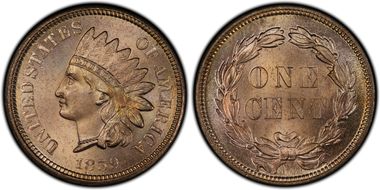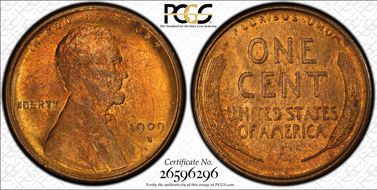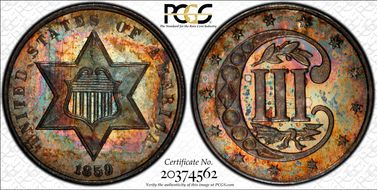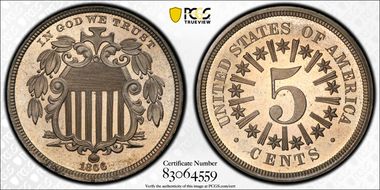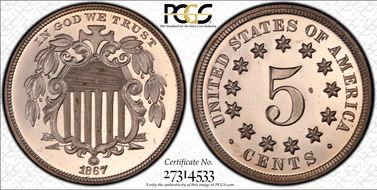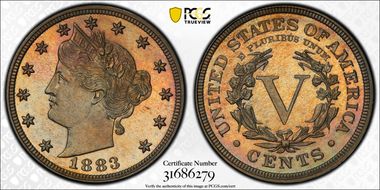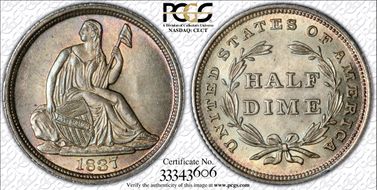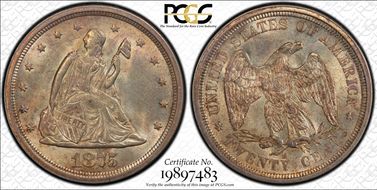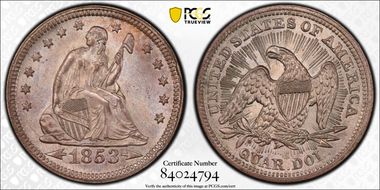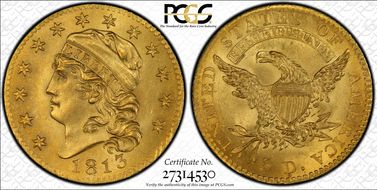The Gypsy Collection 的钱币相册
CAC The surfaces are bright red with a hint of yellow, as often seen. The "Brown" part of the grade is from the woodgrain toning over each side. This is common to all 1909 cents, both Indian and Lincoln types, and is from improper mixture of the alloy. This coin's appearance is most likely just how it looked in 1909.
CAC. Rich gold, green, and blue-plum patina embraces each side of this immensely reflective proof three cent silver. Great eye appeal for early in the series and a simply gorgeous coin, appreciably better-preserved than the "PR65" label on the insert in the first-generation holder.
CAC. Rich gold, green, and blue-plum patina embraces each side of this immensely reflective proof three cent silver. Great eye appeal for early in the series and a simply gorgeous coin, appreciably better-preserved than the "PR65" label on the insert in the first-generation holder.
CAC. Reverse Style D. Stars point to right serif of (STAT)E(S) and between AM. The obverse die is Dannreuther-1, same as on the rare 1867 Rays, with left serif of 1 over right half of a dentil, detached bottom leaf left of the shield, and recutting on the 7. According to research by John Dannreuther, this obverse was used first to strike With Rays proofs on or before Feb. 8, 1867, then No Rays proofs (as here), then more With Rays proof in a later die state. This No Rays Gem shows profound contrast and equal eye appeal over quicksilver surfaces that show no trace of color. A loupe reveals faint recutting on a couple of the reverse stars, but aside from a couple of tiny dark flecks there is little evidence of any post-Mint distractions. 1/0 (7/12) 1/1 (5/13) 1/3 (12/15)
CAC. This stunning piece fully merits the Cameo label, with excellent field-device contrast over the lightly gold-kissed surfaces. A real beauty in hand. PCGS 11/0 (11/09) PCGS 13/0 (11/13) PCGS 18/0 (05/15)
CAC. This stunning piece fully merits the Cameo label, with excellent field-device contrast over the lightly gold-kissed surfaces. A real beauty in hand. PCGS 11/0 (11/09) PCGS 13/0 (11/13) PCGS 18/0 (05/15)
CAC.The austere elegance of Christian Gobrecht's No Stars dime design--Liberty seated against a plain background on the obverse with date below, the reverse with UNITED STATES OF AMERICA around a simple wreath with ONE / DIME inside--makes it one of the simplest but also one of the most classically beautiful 19th century coinage designs. This lustrous, softly frosted Gem offers great eye appeal thanks to broad strokes of blue, violet, green, gold, and orange patina that leave only a few windows of original silver. Population: 25 in 65, 7 finer (11/10)
CAC.The austere elegance of Christian Gobrecht's No Stars dime design--Liberty seated against a plain background on the obverse with date below, the reverse with UNITED STATES OF AMERICA around a simple wreath with ONE / DIME inside--makes it one of the simplest but also one of the most classically beautiful 19th century coinage designs. This lustrous, softly frosted Gem offers great eye appeal thanks to broad strokes of blue, violet, green, gold, and orange patina that leave only a few windows of original silver. Population: 25 in 65, 7 finer (11/10)
CAC. BD-1, R.2. Bass-Dannreuther Die State b/b. The Capped Bust Left design was modified in 1813, with the bust and eagle restyled and the stars arranged in a continuous arc above the portrait, instead of the 7x6 arrangement of the previous design. A substantial mintage of 95,428 pieces was achieved, with only two die varieties known for the date. This coin represents the more available BD-1 variety, identified by the position of the first S in STATES over the right side of E in PLURIBUS. The BD-1 is the only readily available date and variety of this design type, making it a favorite choice of type collectors. The BD-1 probably accounted for 60,000-75,000 pieces of the reported mintage, with a surviving population of 450-650 examples in all grades. John Reich's secret signature star punch, with the notched outside point, was used on star 13. The obverse die was also used to strike the BD-2 variety of this date, but the BD-1 is the only use of the reverse die. As a date, 1813 half eagles have been avidly collected since the 1850s, with an example appearing in lot 187 of the A.C. Kline Sale (Moses Thomas & Sons, 6/1855). More recent sales include the appearance of the present coin in lot 5093 of the FUN Signature (Heritage, 1/2011), which realized $48,875. The coin offered here is a spectacular near-Gem example, with pleasing yellow-gold surfaces and strong rose highlights at the peripheries. The design elements are sharply detailed, and vibrant mint luster beams on both sides. A few light adjustment marks appear on Liberty's cheek on close inspection, but they have little impact on the coin's extraordinary visual appeal. Population: 48 in 64, 3 finer (6/12). 48/4 (1/14)




















